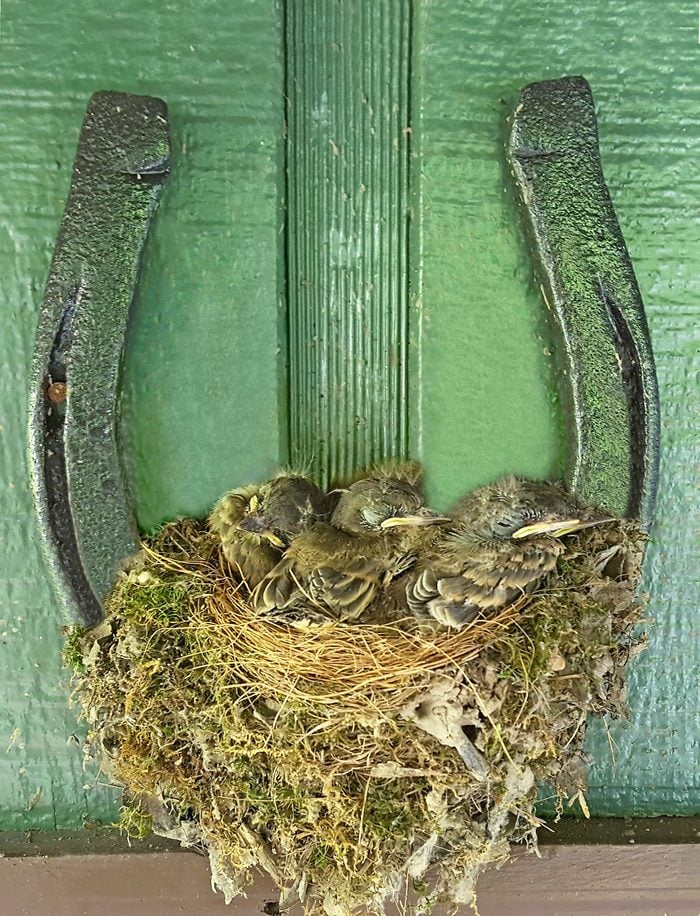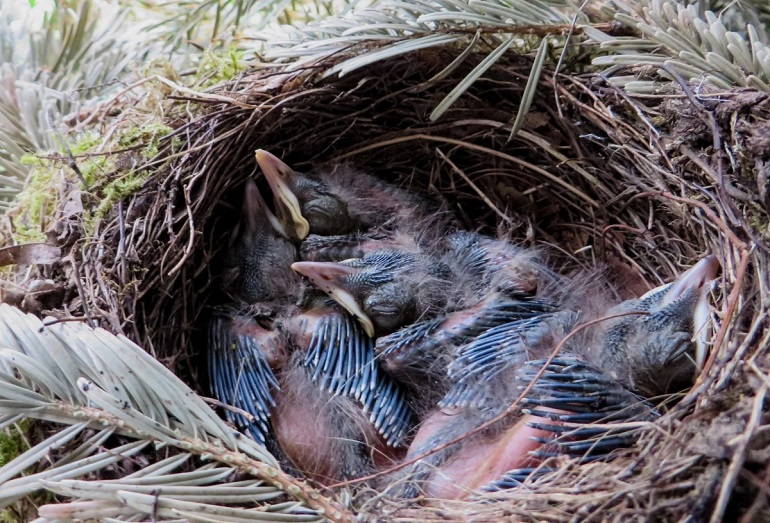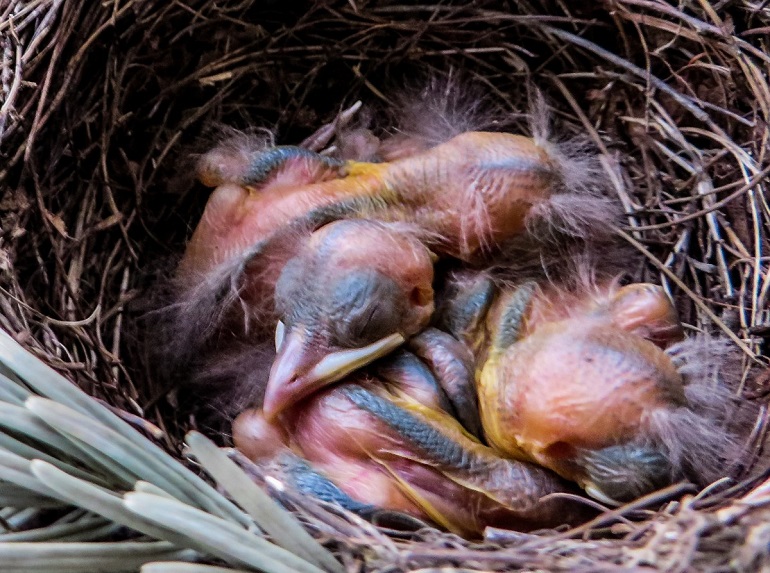Baby birds typically stay in the nest for 2-8 weeks. The exact duration depends on the bird species.
Nesting is a critical period for young avians, a time when fledglings develop and grow under the care of their parents. The length of their stay can be influenced by various factors, including species characteristics, environmental conditions, and the availability of food.
For example, songbirds like robins may leave the nest at around two weeks, while larger birds such as raptors might remain for up to eight weeks or more. This early life stage is marked by rapid physical growth and the beginning of learning vital survival skills. Parent birds work tirelessly to feed their brood and protect them from predators until they are ready to venture out and fend for themselves. Understanding the nesting habits of birds not only enriches our knowledge of avian life but also underscores the importance of habitat conservation for these vulnerable stages of a bird’s life cycle.
Table of Contents
Introduction To Baby Bird Development
Discover the fascinating journey of baby birds as they grow within their protective nests. Nestling periods vary by species, but typically range from 2 to 8 weeks before fledglings spread their wings for the first time.
Witnessing the journey from egg to flight, the development of baby birds is a marvel of nature. Understanding the timeline and stages is essential for bird enthusiasts and conservationists alike. The nesting period is a critical part of this process, encompassing the time from hatching to fledging.
The Bird Nesting Phenomenon
Birds build nests to provide a safe haven for their eggs and chicks. Each species has a unique nesting style, suited to its environment. The nest is not just a home; it’s a nursery where young birds grow and prepare for the outside world.
Key Stages In A Bird’s Early Life
- Hatching: The emergence from the egg.
- Brooding: Parents keep chicks warm and safe.
- Feeding: Chicks are fed a diet by their parents.
- Growth: Rapid development occurs within the nest.
- Fledging: Chicks leave the nest to learn to fly.
Each stage is vital for survival. The duration of the nesting period varies between species. Some birds, like robins, may fledge within two weeks, while others, such as eagles, can take several months. Observing these stages offers insight into the resilience and adaptability of these feathered creatures.

Credit: www.birdsandblooms.com
Eggs To Hatchlings: The Incubation Period
Understanding the journey from egg to hatchling is fascinating. Witnessing the transformation inside the nest stirs curiosity. Birds exhibit varied incubation periods. These range from mere days to several weeks. The incubation period is a crucial stage in the bird life cycle. It ensures the development of healthy chicks.
Timeframe For Egg Incubation
Most birds have a specific time frame for egg incubation. It typically ranges between 10 to 30 days. Smaller birds tend to have shorter incubation periods. Larger birds may take longer to hatch.
Common incubation periods:
- Songbirds: 10-14 days
- Waterfowl: 21-28 days
- Raptors: 35-42 days
Factors Affecting Incubation Duration
Various factors can influence how long eggs remain in the nest before hatching. These factors can affect the development and survival of the chicks.
| Factor | Effect on Incubation |
|---|---|
| Temperature | Optimal warmth speeds up development. |
| Humidity | Proper moisture levels are essential. |
| Altitude | Higher altitudes may extend incubation. |
| Parental Care | Consistent sitting by parents is critical. |
Parents play a key role. They maintain egg temperatures and turn them regularly. This ensures even development. Predation and environmental disturbances can also impact incubation success.
Hatchlings: The First Days Out Of The Shell
Hatchlings: The First Days Out of the Shell explore the critical early life stages of baby birds. Right after hatching, these little creatures embark on a rapid journey of growth and development.
Initial Growth Milestones
In the first days post-hatching, baby birds, known as hatchlings, show significant physical changes. Their initial form, mostly featherless and with closed eyes, transforms quickly.
- Day 1: Mostly bald, eyes closed.
- Day 3: Begin to sprout thin feathers.
- Day 7: Eyes start to open, more feathers appear.
This rapid growth prepares them for future survival outside the nest.
Parental Care And Feeding
Hatchlings depend entirely on their parents for food and protection. Parent birds work tirelessly to ensure their young can thrive.
| Activity | Description |
|---|---|
| Feeding | Parents bring food every 15-20 minutes. |
| Warming | Keeps hatchlings warm until they grow feathers. |
| Protection | Shields from predators and harsh weather. |
Through these efforts, hatchlings gradually gain the strength to leave the nest.

Credit: worldanimalfoundation.org
Fledglings: The Transition From Nest To Flight
Witnessing baby birds take their first leap towards the sky is a marvel of nature. In the journey from nestlings to fledglings, these young birds prepare for the crucial transition to flight. Understanding this phase offers insight into the fascinating world of avian development.
Physical Changes Leading To Flight
As fledglings grow, their bodies undergo significant changes. Feathers replace fluffy down, essential for flight. Wings strengthen, and muscles develop for future aerial adventures. Their weight adjusts, ensuring a balance between strength and lightness for an easy takeoff.
- Feather growth: Necessary for protection and flight.
- Muscle development: Wings must be strong enough to flap effectively.
- Weight management: Optimal for flying.
The Learning Curve Of Flight
Flight mastery doesn’t happen overnight. Fledglings practice tirelessly, starting with short, clumsy hops. Parents guide and encourage, showing how to glide and land. With each attempt, skills sharpen and confidence grows.
| Flight Stage | Activity |
|---|---|
| Initial Hops | Building leg strength and balance |
| Short Flights | Learning wing coordination |
| Higher Flights | Mastering lift and air currents |
Success varies among species, but the process remains rooted in patience and persistence. Eventually, these young birds join their kind in the vast blue expanse, fully fledged and free.
Species-specific Nesting Durations
The time baby birds spend in their nests can vary widely among species. Understanding these durations helps us appreciate the delicate and critical stages of avian development. Each species follows its unique timeline, influenced by factors such as size, habitat, and behavior. Let’s explore these fascinating variances with some specific examples.
Variations Among Different Bird Species
Birds have diverse nesting habits and timelines. Small songbirds may fledge within 2 weeks, while larger birds take longer. Eagles and albatrosses may nest for up to 10 weeks before their chicks are ready to leave. These variations are crucial for survival in their respective environments.
- Robins: 14-16 days in the nest
- Swallows: 18-24 days post-hatching
- Eagles: 8-14 weeks until fledging
Case Studies: Comparing Nesting Times
In a closer look, we compare two species to illustrate the range of nesting durations. Robins, known for their blue eggs, have a relatively short nest stay. In contrast, Bald Eagles have an extended nesting period, allowing for the development of their larger, more complex bodies.
| Species | Nesting Duration |
|---|---|
| Robin | 14-16 days |
| Bald Eagle | 8-14 weeks |

Credit: worldanimalfoundation.org
Environmental Factors Influencing Nesting Periods
Understanding the length of time baby birds spend in the nest is crucial. It’s not just about counting days. The environment plays a key role. Let’s explore how different factors influence the time these young birds stay under their parents’ care before they take their first flight.
Impact Of Climate And Geography
Climate and geography significantly affect bird nesting periods. In warmer regions, baby birds may leave the nest earlier. This is due to faster growth rates in such climates. Conversely, in colder areas, the nesting period extends as baby birds need more time to develop fully.
- Warm climates: Shorter nesting periods
- Cold climates: Longer nesting periods
Geography also influences food availability. Birds in rich habitats tend to fledge faster due to abundant resources.
The Role Of Predation And Human Interaction
Predation is a constant threat to baby birds. Parent birds may choose safer, but less ideal, locations to avoid predators. This can lead to longer nesting periods. Human interaction, such as noise and disturbance, also impacts nestlings. Birds in urban areas face different challenges compared to those in undisturbed habitats.
| Factor | Effect on Nesting Period |
|---|---|
| Predation | May increase nesting time for safety |
| Human Interaction | Can cause stress, affecting fledging time |
Areas with high predation risk: Longer stays in the nest.
Human busy environments: Potentially erratic fledging times.
The Final Flight: Signs Of Nest Departure
As the fledgling period reaches its end, baby birds prepare for a significant milestone in their young lives: leaving the nest. This event, often referred to as the final flight, marks the transition from nest-bound infant to a more independent juvenile bird. Understanding the signs of nest departure can help birdwatchers and nature enthusiasts recognize this pivotal moment.
Behavioral Cues For Leaving The Nest
Baby birds exhibit distinct behaviors indicating their readiness to leave the nest:
- Wing flapping: Strengthens flight muscles
- Perching: Practice balance on nest edge
- Increased activity: Signals energy and curiosity
- Mock flights: Hopping and fluttering near nest
- Feeding less: Parents encourage self-sufficiency
Survival Strategies Post-departure
Once the baby birds embark on their first flight, survival becomes their priority. Here are strategies they adopt:
| Strategy | Description |
|---|---|
| Finding food | Locate sources independently |
| Avoiding predators | Stay alert and seek cover |
| Building strength | Continuous flying and foraging |
| Learning calls | Communicate with parents and flock |
These strategies are crucial for the young birds’ survival outside the comfort of their nest.
Conservation And Human Impact On Bird Nesting
Conservation and human impact significantly influence bird nesting. Understanding these factors helps protect these delicate phases of a bird’s life cycle.
Protecting Nesting Sites
Nesting sites are crucial for the survival of baby birds. Efforts to protect these areas can greatly boost bird populations.
- Use of signage to deter human disturbance.
- Legal protection for critical habitats.
- Public education on the importance of these sites.
These actions ensure that baby birds can grow safely in their natural habitats.
The Effect Of Urbanization On Bird Development
Urban areas can alter the natural environment needed for birds to thrive. Urbanization presents challenges to bird development.
- Loss of natural habitats leads to fewer nesting sites.
- Increased noise and light pollution can disrupt bird behaviors.
- Pollutants in the environment can harm young birds.
Addressing these issues is key to supporting urban bird populations.
Frequently Asked Questions
How Long Does It Take For Baby Birds To Fly Out Of The Nest?
Baby birds typically take 2 to 4 weeks to fly out of the nest after hatching, depending on the species.
Do Baby Birds Go Back To The Nest At Night?
Baby birds typically do not return to the nest once they’ve left and begun to fledge. They start learning to forage and sleep outside of the nest.
How Long Do Mama Birds Stay With Their Babies?
Mama birds typically stay with their babies for 2 to 8 weeks, depending on the species, until they are ready to fledge and become independent.
How Long Does It Take For Birds To Leave Their Nest?
Birds typically leave their nest about 2 to 5 weeks after hatching, depending on the species. The exact time varies, as each bird grows at its own pace and species have different maturation rates.
Conclusion
As we’ve explored, the duration baby birds spend in the nest varies by species. Typically, this period ranges from two weeks to a month before fledglings take flight. Understanding these timelines helps birdwatchers anticipate and respect the delicate nesting phase.
Remember, a little patience goes a long way in observing the natural progression of these feathered families.


